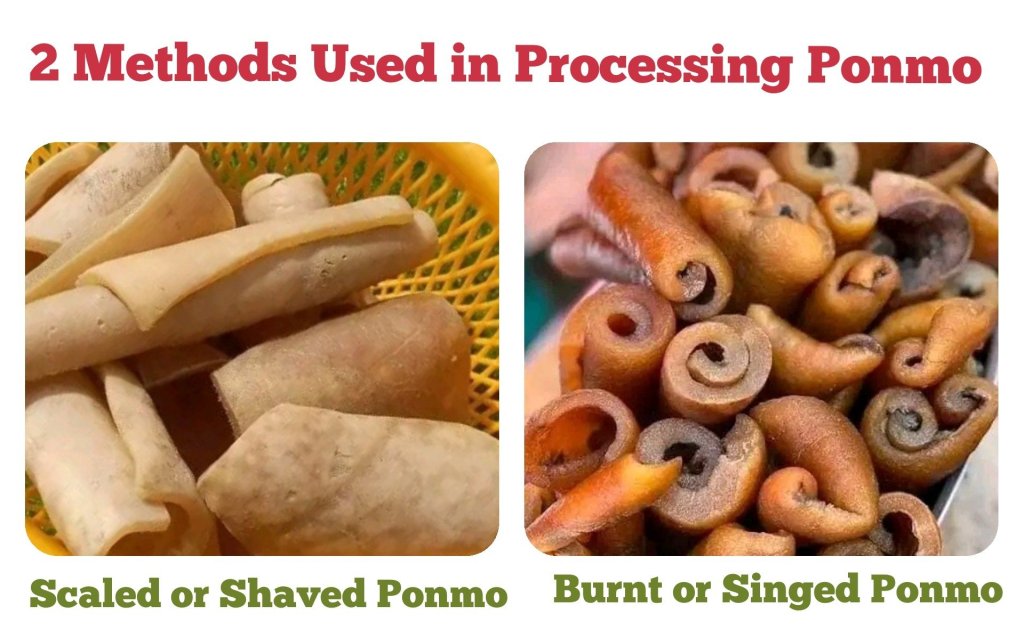Lots of confusion have risen over whether Ponmo has any benefit or not.
Dedicated Ponmo eaters have given deaf ears to all these debates, and have vowed to cherish their delicacy whether or not it has any nutrients.
Some health researchers claim it has no benefit at all.
Some said it is very dangerous to health and should be avoided.
Some say it is better than red meat (beef), and others believe it has some nutrients although in smaller quantities but may pose a great risk to health if not processed well.

…….This is where many patriotic Ponmo eaters believed the whole fuss started.
When you eat Ponmo (cowskin), also known as kanda or kpomo, you indirectly consume the raw material for leather production such as leather cushions, shoes and belts.
So to say, the innocent consumption of Ponmo has made the quantity of raw animal skin reduce drastically.
Implying that tanneries can’t meet up to the demands in production if they hope on local sources only. Coupled with the fact that it’s easier for butchers to sell the animal skin for consumption rather than to tanneries.
Owning to that, they import most of the leathers they use for their work.
Their lament is believed to be one of the reasons the government placed a ban on Ponmo consumption.
However, a devoted member of the “Nigerian Association of Pomo Lovers (NAPOL)” responded that those in tanneries should rear more cows for their use if they so much need the skin or use synthetic leathers which is even rampant but leave Nigerians alone to enjoy their Ponmo in peace.
Many others believe it’s just a lie from the government to cause more affliction on the poor masses. Since Ponmo is relatively cheaper.
What is a pot of soup or stew without Ponmo? Another angry Ponmo lover said.
Well, Ponmo is here to stay and it may interest you to know about its benefits and dangers to health.
What are the Risks or Dangers of Eating Ponmo?
There are two major reasons Ponmo may be harmful to health.
1. Animal diseases
Most of these cattle rearers don’t even take care of themselves, let alone their cattle. Giving them food and water is all they care about.
Good Hygiene is far from them. Owning to that, these cattle are prone to skin diseases and infections like (mastitis infections).
To make matters worst, they don’t have access to veterinary clinics or even animal health officers. Rather than properly treating these animals, they mostly resort to injecting them with antibiotics which may be harmful.
Most of the affected livestock die with most of the harmful injectables still stuck on the skin.
These chemicals and diseases on the skin make Ponmo unfit for consumption.
According to some health experts; thorough washing and proper cooking may not be enough to eliminate chemicals or kill the bacteria present.
2. Exposure to harmful substances
During the singeing of cow’s hair (slight burning with flame), the meat is exposed to many harmful chemicals.
Such as tyres, engine oil, metals, and other unhygienic substances.
Not only do these flames cause air pollution, but the chemicals and toxins also find their way into the meat leading to contamination.
Although some have been encouraged to use the traditional method of boiling in water and shaving afterwards, others still prefer it burnt due to its convenience.
Even, there have been rumours of some sellers soaking the cowskin in chemicals (such as formalin) to increase the thickness so they can make more sales.
Apart from making the meat unsafe, it also makes it unnecessarily soft and tasteless.
So when you see that kind of oversized Ponmo, run for your safety.
All these unsafe practices are what makes Ponmo a threat to our health, (NOT the Ponmo itself) as it can lead to cancer and damage to the organs of the body like the kidney and liver.
To minimise the risks involved, the herders, the butchers and the traders should be enlightened on how to make the meat safe for consumption.
Nutritional Values of Ponmo (Cow Skin)
Contrary to what many people think or believe, Ponmo has some nutritional value that makes it worth eating. Although most of them are in minute amounts.

Comparing scaled and singed Ponmo, studies show that the former possess a higher percentage of nutrients than the latter.
So scaled or shaved Ponmo (usually white) is not only safer but more nutritive.
Thus, it’s highly recommended.
Nutrients in Ponmo (the ranges are for both the white scald and black singed Ponmo)
According to Al-Qadisiyah Journal For Agriculture Sciences (QJAS).
- Moisture% = 23.80 – 67.02
- Energy% = 6.80 – 131.50
- Protein% = 8.77 – 30.75
- Total Fat% = 0.42 – 3.30
- Ash% = 0.41 – 1.48
Mineral composition (mg/100g)
- Phosphorus = 0.40 – 2.10
- Calcium = 3.60 – 17.20
- Zinc = 2.24 – 6.84
- Iron = 4.30 – 21.10
- Magnesium = 4.62 – 17.20
- Potassium = 4.30 – 14.80
- It also contains Fibre and collagen (a form of protein)
Health Benefits of Ponmo (Cow Skin)
- Rich in collagen, a protein mostly found in the skin, bones, and connective tissues.
It helps to keep the skin healthy and smooth. - Collagen also increases bone strength and prevents bone density loss.
Coupled with the fact it contains phosphorus and calcium that helps to build strong bones. - Improve digestion and bowel movement due to its fibre content.
Conclusion
Ponmo is safe to eat if all the unsafe practices mentioned are replaced with hygienic ones.
Again to say it has no nutritional value is false as some studies have proven it to possess some nutrients regardless of how little it may be.

